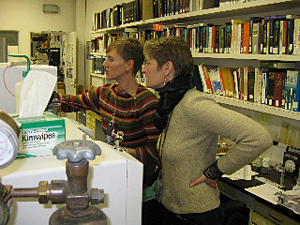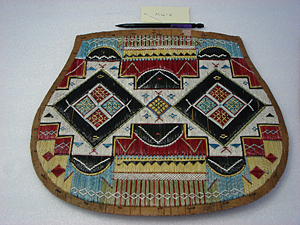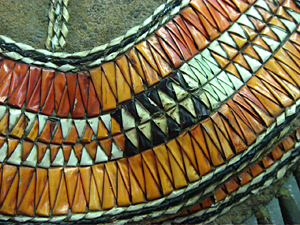
- Rozovsky wins prestigious NSF Early Career Award
- UD students meet alumni, experience 'closing bell' at NYSE
- Newark Police seek assistance in identifying suspects in robbery
- Rivlin says bipartisan budget action, stronger budget rules key to reversing debt
- Stink bugs shouldn't pose problem until late summer
- Gao to honor Placido Domingo in Washington performance
- Adopt-A-Highway project keeps Lewes road clean
- WVUD's Radiothon fundraiser runs April 1-10
- W.D. Snodgrass Symposium to honor Pulitzer winner
- New guide helps cancer patients manage symptoms
- UD in the News, March 25, 2011
- For the Record, March 25, 2011
- Public opinion expert discusses world views of U.S. in Global Agenda series
- Congressional delegation, dean laud Center for Community Research and Service program
- Center for Political Communication sets symposium on politics, entertainment
- Students work to raise funds, awareness of domestic violence
- Equestrian team wins regional championship in Western riding
- Markell, Harker stress importance of agriculture to Delaware's economy
- Carol A. Ammon MBA Case Competition winners announced
- Prof presents blood-clotting studies at Gordon Research Conference
- Sexual Assault Awareness Month events, programs announced
- Stay connected with Sea Grant, CEOE e-newsletter
- A message to UD regarding the tragedy in Japan
- More News >>
- March 31-May 14: REP stages Neil Simon's 'The Good Doctor'
- April 2: Newark plans annual 'wine and dine'
- April 5: Expert perspective on U.S. health care
- April 5: Comedian Ace Guillen to visit Scrounge
- April 6, May 4: School of Nursing sponsors research lecture series
- April 6-May 4: Confucius Institute presents Chinese Film Series on Wednesdays
- April 6: IPCC's Pachauri to discuss sustainable development in DENIN Dialogue Series
- April 7: 'WVUDstock' radiothon concert announced
- April 8: English Language Institute presents 'Arts in Translation'
- April 9: Green and Healthy Living Expo planned at The Bob
- April 9: Center for Political Communication to host Onion editor
- April 10: Alumni Easter Egg-stravaganza planned
- April 11: CDS session to focus on visual assistive technologies
- April 12: T.J. Stiles to speak at UDLA annual dinner
- April 15, 16: Annual UD push lawnmower tune-up scheduled
- April 15, 16: Master Players series presents iMusic 4, China Magpie
- April 15, 16: Delaware Symphony, UD chorus to perform Mahler work
- April 18: Former NFL Coach Bill Cowher featured in UD Speaks
- April 21-24: Sesame Street Live brings Elmo and friends to The Bob
- April 30: Save the date for Ag Day 2011 at UD
- April 30: Symposium to consider 'Frontiers at the Chemistry-Biology Interface'
- April 30-May 1: Relay for Life set at Delaware Field House
- May 4: Delaware Membrane Protein Symposium announced
- May 5: Northwestern University's Leon Keer to deliver Kerr lecture
- May 7: Women's volleyball team to host second annual Spring Fling
- Through May 3: SPPA announces speakers for 10th annual lecture series
- Through May 4: Global Agenda sees U.S. through others' eyes; World Bank president to speak
- Through May 4: 'Research on Race, Ethnicity, Culture' topic of series
- Through May 9: Black American Studies announces lecture series
- Through May 11: 'Challenges in Jewish Culture' lecture series announced
- Through May 11: Area Studies research featured in speaker series
- Through June 5: 'Andy Warhol: Behind the Camera' on view in Old College Gallery
- Through July 15: 'Bodyscapes' on view at Mechanical Hall Gallery
- More What's Happening >>
- UD calendar >>
- Middle States evaluation team on campus April 5
- Phipps named HR Liaison of the Quarter
- Senior wins iPad for participating in assessment study
- April 19: Procurement Services schedules information sessions
- UD Bookstore announces spring break hours
- HealthyU Wellness Program encourages employees to 'Step into Spring'
- April 8-29: Faculty roundtable series considers student engagement
- GRE is changing; learn more at April 15 info session
- April 30: UD Evening with Blue Rocks set for employees
- Morris Library to be open 24/7 during final exams
- More Campus FYI >>
10:39 a.m., June 29, 2009----“It was a case of a chemist looking for a project and a project looking for a chemist,” said Christina Cole, a University of Delaware doctoral student in preservation studies, whose research involves analyzing the dyes used in highly decorative and colorful quillwork by Native Americans.
Cole has been awarded a dissertation fellowship for her work by the American Association of University Women's (AAUW) Educational Foundation. Fellows are “exceptional women whose work promises to enhance such diverse disciplines as biology, philosophy and anthropology,” according to AAUW.
Cole was among the 64 fellows chosen from 1,175 applications and received a $20,000 award.
She also is a Coremans Endowment fellow, which funds doctoral students in art preservation.
Early Native Americans have used the dyed quills of porcupines for intricate, colorful decorative work, predating glass beadwork, for stoles, bags, cradleboards, moccasins, wall hangings and other objects.
Cole recalls when she first became aware of quillwork while working at the Freer/Sackler Galleries and analyzing pigments and dyes in Chinese art. She met a Lakota traditional arts instructor through the National Museum of the American Indian, who commented that no one had analyzed the dyes used in Native American quillwork. She discovered he was right, and her research project was launched, she said.
Unfamiliar with quillwork, Cole said the first time she saw it at the McCord Museum in Montreal, it was “Wow!”
“I was surprised, enchanted and astonished, and it took me a while to start examining quillwork from a clinical point of view,” she said.
Cole is studying quillwork predating the 1850s, but quillwork continues today, she said. One source of quills unfortunately is road kill, she said, with the porcupines dying from salt on the roads. “Or you can throw a blanket over a porcupine and then remove the quills from the blanket,” she said. Porcupines do not throw quills but they are easily detached, and the animals grow new ones.
The quills are sorted by size and dyed and folded to make quillwork.
There have been studies as to what dyes may have been used but none that completely eliminate uncertainty by examining the quillwork itself, Cole said. Thanks to modern technology and her research, many of the dyes now can be accurately pinpointed.
Most of Cole's research is carried out at the National Gallery of Art where she uses their liquid chromatography-mass spectrometry instrument to analyze the dyes of quillwork from several collections.
“My goal is to be as non-invasive as possible, using swabs, for instance, to gather the material and to develop non-destructive methods of analysis,” she said.
“The guesses people have made about the dyes were reasonable,” Cole said. She will be able to confirm that some black dyes are from walnut trees or from tannin, some blues from indigo or wild grapes, some yellows from golden rod, and red/orange dyes from bloodroots. Even poison ivy may have been used as a dye.
By figuring out the dyes, researchers can make better-informed decisions about how to preserve and interpret quillwork, as well as giving information on the dyes to Native American communities, Cole said.
An analytical chemist and conservation scientist, Cole has worked as the sole chemist for the National Air and Space Museum, working on protecting objects in the collection. Before that she was a conservation scientist for the Freer/Sackler galleries working on East Asian paint pigments analysis and also worked for the U.S. Naval Research Laboratory.
A graduate of North Carolina State University, Cole has a master's degree in analytical chemistry from the University of Michigan and spent time over two years at Oro e Colore, a restoration school in Italy working on paintings on canvas.
Article by Sue Moncure




